“Do you expect me to talk?”
“No, Mr. Bond, I expect you to die!”
–from Goldfinger
The name is Bond—James Bond; the most famous superspy of them all. It’s been fifty years since Sean Connery first embodied him in Dr. No, and with the current raves for Daniel Craig’s Skyfall, we have a great opportunity to see how an iconic movie character—and the actors who’ve portrayed him—can be a real mirror of the times. The longest-running franchise in film history, the Bond movies actually embody the astrological energies at work during different decades, and the various actors’ birth charts can tell us why they succeeded, or failed, at their job. It’s quite a fascinating journey!
James Bond is, archetypally, pure Scorpio energy. He’s a spy, first of all, someone who’s secretive, prone to violence, highly sexual, and who wields a sarcastic wit. Quick-thinking and suave but suppressed emotionally, and sometimes as vengeful as his enemies, he’s a man of action and passion—a ruthless sort who faces down a lot of death. In fact, he causes death as part of his job. Power issues surround him, usually coming from some domineering enemy. He must continually prove himself, transcending limitations of danger and fear. Indomitable, courageous, he always wins in the end. Plus, he gets the girl—often a whole passel of them! All of these traits describe Scorpio in its pure, unadulterated state. The Bond character puts a face on one of the twelve zodiac signs as clearly as we can possibly hope for.
British author Ian Fleming was born under Gemini, the sign of the writer. Here is Fleming’s astrological chart:
Fleming came from a wealthy family, indicated by his having the Moon (indicating family background) in Taurus, the sign of money. As a social aristocrat, he valued personal refinement and gave Bond some of this suavity. While working as special assistant to the head of British naval intelligence during World War II, he was involved in planning secret operations…one of them called Operation Golden Eye, later used as the name of his writing retreat in Jamaica and the film, GoldenEye.
Fleming’s first Bond novel, Casino Royale, was published in 1953, to immediate success. There followed eleven more Bond novels and two short story collections. He also wrote the children’s story, Chitty-Chitty-Bang-Bang, best known as a charming 1968 movie. The Bond stories are among the best-selling fictional books ever published, selling over 100 million copies worldwide. All of this is in keeping with Fleming’s Sun and Moon being well-situated in the 3rd House of writing, speaking and high IQ. His mother lobbied the head of Reuters news agency to give him a job after he was dismissed from Eton College for enjoying a mildly dissipated lifestyle, and Fleming thereafter became a journalist who traveled the world… activities suited to one whose Luminaries resided in that restless 3rd House.
During Fleming’s wartime activities, he originated many schemes to mislead German forces, dispensing misinformation and becoming intimately acquainted with secret codes and tactical uses of force. That he had talent in this area is shown by the placement of Uranus (chaos/technology) in Capricorn (sign of government) in the 12th House of secrets. He worked closely with Col. “Wild Bill” Donovan, FDR’s special intelligence envoy to England. It’s easy to see in Donovan the inspiration for Felix Leiter, Bond’s counterpart in the CIA.
Fleming’s Rising Sign is Aquarius, famous for being future-oriented and enamored of new technology. Fleming was something of a geek, essentially Tom Clancy’s literary godfather. Fleming’s novels are Cold War morality tales featuring a character he called “a blunt instrument in the hands of the government,” and technology plays no small part in the plots. It was not his fault that it became so overblown in the films, and he probably would have laughed along with us at Maxwell Smart and Austin Powers. Yet, prophetically, technology now informs our everyday lives.
That Fleming had a creative destiny is shown by his Mercury (mentality), Mars (sexuality/drive/conflict), Neptune (imagination) and North Node (life destiny point) all residing in his chart’s 5th House, which rules creativity and pleasures of life. Fleming lived in Jamaica, had flings with hot, wealthy women, was also married and eventually smoked and drank himself to death in 1964 at age fifty-six. One day he invented the “Vesper martini” as an alternative to going to a 5 p.m. church service called Vespers. (Ingredients: vodka, gin, Kina Lillet vermouth and a lemon peel for garnish.)
Fleming’s success with Bond is indicated by Scorpio, sign of the spy, occupying the top of his chart. Fleming’s and Bond’s careers, in other words, had much in common. He said he modeled Bond on a number of people he met during his intelligence career: among others, his brother Peter, the artist Hoagy Carmichael, and an elegant station head of MI6 in Paris. But it’s clear to biographers—and especially to an astrologer—that Fleming put much of his own personality into Bond. Curiously, the world’s most famous spy got his name from an American ornithologist, an expert on Caribbean birds. Fleming read his book and thought the author’s name, James Bond, spoke to a strong, terse Anglo-Saxon type of masculinity. (There’s the Gemini obsession with words!)
Fleming was happy to sell the movie rights to his books. But it took him a while to warm up to the actor who originated the role on screen, and who remains in many minds the definitive Bond.
Sean Connery’s chart is shown below:
Connery had been acting in local productions when he auditioned for Bond by dressing scruffy, acting macho and throwing out a devil-may-care vibe. He was hired immediately and given a little social tutoring by director Terence Young. By the time Dr. No was filmed, Connery’s sex appeal shone through and his Bond took the world by storm.
Sean Connery was born a Virgo with Neptune (glamour/imagination) sitting next to the Sun (self-image) in the 8th House associated with sex, death and regeneration. That’s a sexy (and potentially dangerous) energy combo if there ever was one! Connery’s Moon (emotional self/appeal to women) also occupies Virgo, in the 9th House of internationality…or perhaps we should say, “foreign affairs.” What is James Bond if not the original international man of mystery? Connery’s solar and lunar placements point to how well the role of Bond fitted his own energy.
The key to understanding Connery’s chart, though, is his tough-natured Capricorn Ascendant (projection of take-charge authority), with Capricorn’s ruling planet, Saturn (command and accomplishment), also sitting right there on the angle. Connery always projected an alpha male energy and he used it to great effect in his movie roles. Capricorn’s associated with tradition (Connery is a patriotic Scotsman) and with longevity (he acted into his 70s), so he’s had a long-lasting career of great influence.
The “love ‘em and leave ‘em” persona of Bond can also be found in Connery’s chart, in the guise of a Venus-Uranus opposition from romantic Libra to feisty Aries. When love comes to Bond, it’s usually exciting, short-lived and volatile. Connery himself has had a long, stable marriage, but the energy for Bond came from somewhere, and Sir Sean has made some controversial statements about women. Jupiter (abundance) and Pluto (power) both sit in the 7th House of relationships in Cancer, a sign of emotional bonding. (!) Connery’s appeal to women is legendary.
Women may have wanted him, but men wanted to BE him! We find this energy depicted in the square (hard, 90-degree “I-gotta-be me” angle) that Connery’s Mars (sex/conflict/physicality) makes to both his Moon (emotions) and Mercury (intelligence/wit). This is the astrological definition of charisma. The Bond films played off Connery’s natural energy and the result was a lasting worldwide phenomenon.
What energy was afoot when Dr. No premiered, that gave the series such longevity and appeal? Here is the chart for the movie’s premiere at the London Pavilion:
October 5th, 1962 happened to have as its signature a Libra Sun (romance/artistry) and a late Sagittarius Moon (expansiveness/exotic fun). By itself, this was fortuitous, but add in Venus in Scorpio (sex/obsessions), Mars (action/violence) in a fortunate trine to Venus, and an exact Jupiter-Uranus opposition (sudden good fortune), and the astrological picture is very encouraging. Saturn (longevity/tradition) is the most elevated planet in the chart. Mercury retrograde speaks to how many times the series has had to be rebooted, but it would be hard to pick a more fortunate astrological moment to launch such a franchise.
In Connery’s chart, Uranus (breakthroughs) was precisely conjunct Neptune (glamour/creativity), which meant that Jupiter (conveying blessings) also formed an exact opposition. The man and the character—and the franchise—became one in the public’s eyes. Connery WAS Bond.
Because the Bond franchise continued, it not only participated in the evolving astrological energies of the 1960s, it became part of the cultural revolutions of the decade as well. It has, after all, been the expressed intent of the producers to keep James Bond relevant to the moment, and this means the films mirror not only the times but the larger energies at work. Dr. No unwittingly premiered just two weeks ahead of the Cuban Missile crisis, the closest we have come to nuclear destruction. What are the Bond films mostly about? Defeating a power-mad super villain and saving the world from destruction.
As they went on, the Sixties became more liberated because of the rare transit of Uranus (youth/innovation/revolution) conjunct Pluto (sex/power/obsessions). One could argue that the sexual revolution was helped along by the Bond films and their playful, glamourized spin on sexuality. (Nude females were not yet a common sight.) The films were naughty in a delightful way and Western culture loved it. Sean Connery’s Bond was a symbol of macho confidence in matters of state (he always won), but was also something of a cultural breakthrough. Sex (and glamourized violence) was part of life now. The repression of the Fifties was gone.
After filming Dr. No, From Russia With Love, Goldfinger, Thunderball and You Only Live Twice, Connery tired of the role. Though he returned for Diamonds Are Forever and what’s considered an unofficial Bond entry, Never Say Never Again, he was replaced in the film On Her Majesty’s Secret Service by a very unlikely prospect…who actually did rather well in the role, if only briefly.
This is the chart of George Lazenby:
We do not know Lazenby’s time of birth, and must content ourselves with looking at the astrological aspects in his chart…but these are quite revealing.
Like Connery, Lazenby was born a Virgo, with Venus (ruler of good looks) conjunct his Sun (personality). Additionally, Neptune (creativity/glamour) was still occupying Virgo as it had in Connery’s chart. That could make for a very handsome, popular man! Lazenby was born under a Grand Trine, a very fortunate, creative energy. The signs Virgo, Taurus and Capricorn are all occupied. A Moon-Uranus conjunction (emotional electricity) in the sign of Taurus (money/sensuality), and a well-aspected Mars (sexuality/conflict) in Capricorn (business/authority) complete the picture of a confident, suave sophisticate who would probably do very well in life.
Lazenby was known not as an actor, but a model. He had done an ad for Big Fry Chocolate Creams, and with his GQ looks and debonair manner was considered a man of visible refinement. He happened to have the same barber as Bond producer Albert Broccoli, and when they met one day over haircuts, Broccoli invited him to audition for Bond. He came to the screen test dressed to the nines, accidentally punched out a stuntman and got the job due to his looks and aggressive mannerisms.
On Her Majesty’s Secret Service is now considered one of the better Bond films. It co-starred Diana Rigg and is the only time in the series that Bond actually gets married. Unfortunately, Lazenby had big shoes to fill and at the time of release his turn as Bond was considered to be several grades below that of Connery. Time has been kind to OHMSS, however, and Lazenby’s less witty, more assertive performance is now considered closer to Fleming’s original conception of Bond than Connery’s interpretation. It’s simply a more serious film.
But the stars—or at least the director, Peter R. Hunt—were against Lazenby continuing. For some reason, Hunt wouldn’t speak to Lazenby directly while on the set. Fed up with it all even before the film’s release, Lazenby simply walked away. Astrologically, that tumultuous Uranus-Pluto conjunction was crossing Lazenby’s Neptune (creativity/confusion/deception) during the time of shooting. It was never going to be an easy time for him. December, 1969, when OHMSS premiered, was also the month of Altamont, when a young man was murdered at a Rolling Stones concert and the spirit of the Sixties effectively died. So, in the movie, did Bond’s wife. It was just a heavy time.
Playing James Bond, George Lazenby only lived once.
NEXT, IN PART TWO: James Bond is both shaken and stirred! The filmic times (and personal charts) of Roger Moore, Timothy Dalton, Pierce Brosnan & Daniel Craig.
007 lives on!

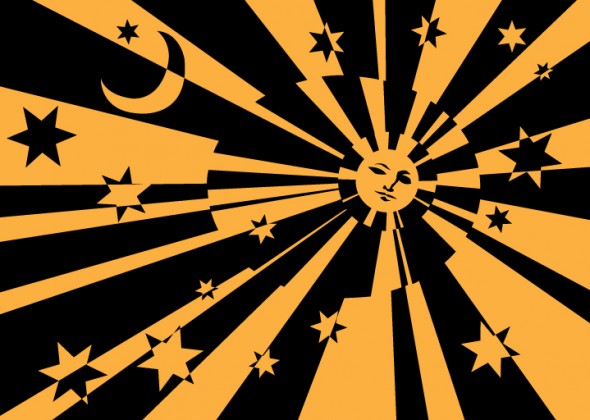
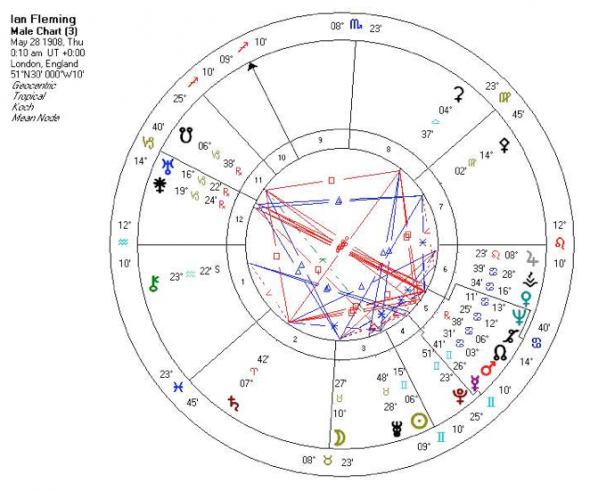
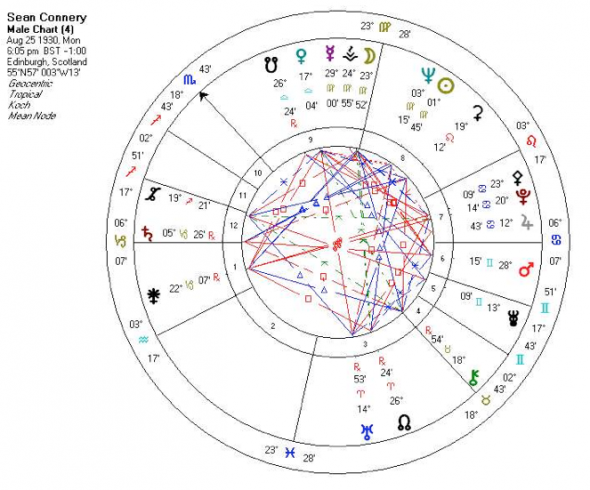
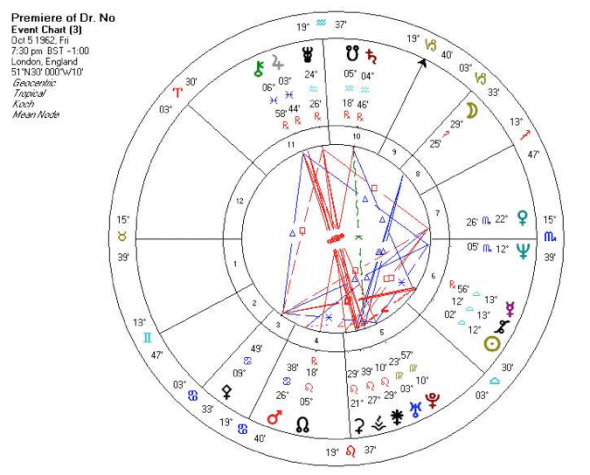
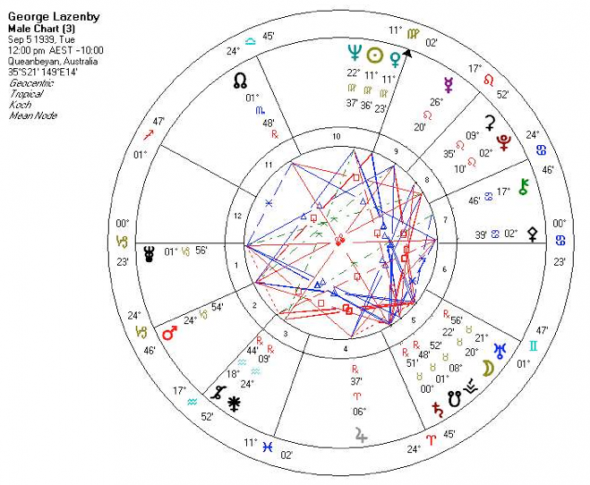







1 Comment
Why hasn’t anyone commented on this, This was an Awesome breakdown!